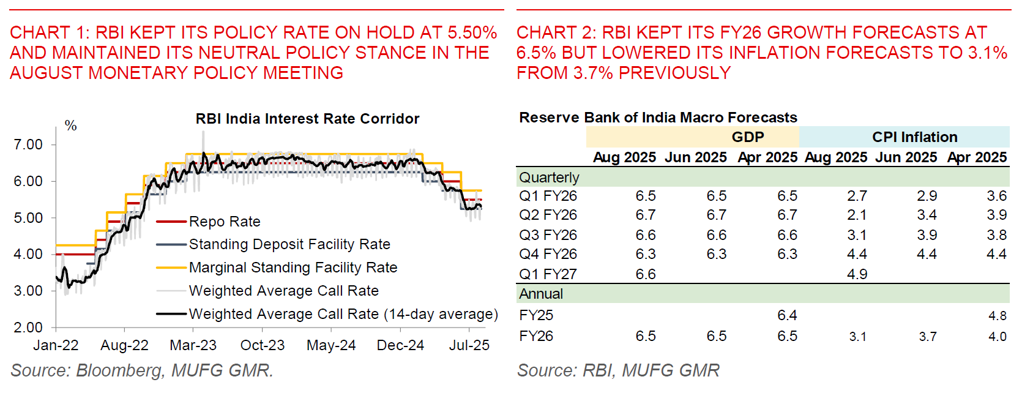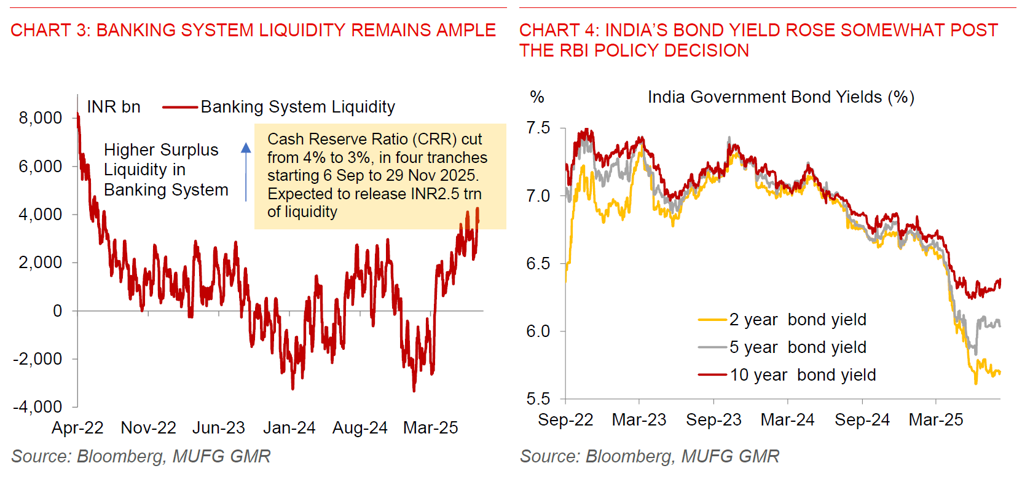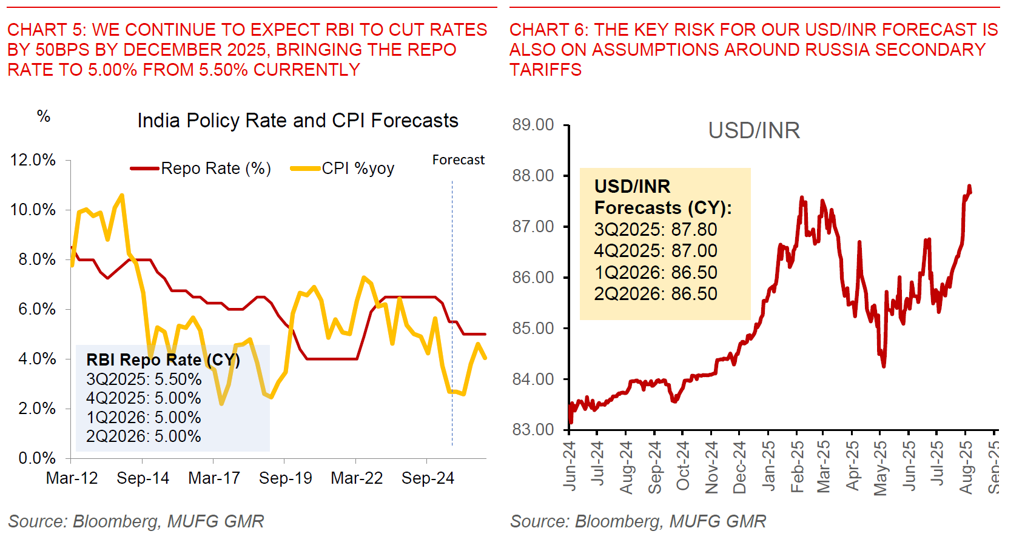- The Reserve Bank of India kept its key repo rate on hold at 5.50%, in a unanimous vote, while also keeping its neutral policy stance unchanged.
- This decision was expected by ourselves and the market, although we note that the consensus was also understandably more split given recent developments on India’s tariffs by the Trump administration.
- Overall, our assessment is that RBI is likely too optimistic on its growth forecasts and by the same logic we also see RBI’s inflation forecasts likely implying too strong demand-pull related inflation.
- Of course, tariff assumptions are also key and a difficult moving target to pin down. Our current forecasts are for GDP to average 6.1% for FY26 growth and 3% for FY26 – below the RBI’s forecasts – with 25% tariffs cutting India’s growth by 0.3pp over time (India-US trade talks and tariffs – Delayed and denied?).
- We as such continue to forecast RBI to cut rates by another 50bps, likely by 25bps each in the October and December meetings, which would bring the repo rate to 5.00% from 5.50% currently.
- An important uncertainty including on USD/INR is on possible Russia secondary sanctions on India, and whether this ultimately proves to be a negative demand shock for India – through materially higher tariffs on India’s exports – or conversely a negative supply shock through higher global oil prices if Russia oil gets taken off global markets. RBI rate cuts look more likely in the former, but less so in the latter. Nonetheless, as we highlighted in our latest report, we are extremely hesitant to build in these risks in our FX and rates forecasts, both because there are alternative scenarios of an eventual resolution in the Russia-Ukraine war, and also because global oil supplies are still ample.
- We forecast USD/INR at 87.00 by Dec 2025 and 86.50 by March 2026, with the assumption that India’s tariffs are eventually lowered to 20% by October, and also we are not assuming material Russia secondary tariffs on India on an extended basis.

Details:
- RBI Governor Sanjay Malhotra highlighted that the past effects of the 100bps rate cuts are still unfolding and transmitting to the economy, including into credit growth. Meanwhile, inflation is also expected to rise above 4% into 2026 in part due to base effects and as demand improves. As such, the RBI’s Monetary Policy Committee will remain data-dependent, with growth thus far holding up and evolving along RBI’s current assessments. This is even as the uncertainties of tariffs are still currently evolving.
- RBI also kept its FY2026 GDP forecast at 6.5%, but lowered its FY26 inflation forecast to 3.1% from 3.7% previously. Nonetheless, RBI is also forecasting CPI inflation to rise to 4.9% in 1Q FY2027/28, likely implicitly building in some demand-pull inflation, or at the very least some cost-push inflation from higher food prices.
- Meanwhile during the press conference, there were several questions surrounding the impact of tariffs on India’s macro outlook and also the impact of possible Russia secondary tariffs.
- In general, RBI Governor Malhotra said that India is less dependent on external factors compared to other economies, and the impact to India’s inflation from tariffs are likely to be balanced by impact of slower growth as well, absent substantial retaliatory tariffs which are not RBI’s base case assumptions.
- The Governor also said that it is difficult to predict what the impact of tariffs are, and the RBI does not have sufficient data to revise their GDP forecasts currently.
- The impact from Russian oil according to the Governor would also depend on the mix of oil sources that India takes – of which there are many, global commodity prices, and also importantly any fiscal offsets that the government does including on lowering excise duties.
- In terms of the transmission of lower RBI rates to lending rates, RBI’s study shows that there has been a 71bps reduction in Weighted Average Lending Rates (WARL) thus far from the 100bps repo rate cut and of which, 50bps is due to changes in actual lending rates and not change in the mix of loans that has happened.
- Meanwhile, the RBI will soon publish for public consultation the proposal for a new framework for liquidity management.
- According to the Governor, the panel on liquidity management has recommended continuing to target the Weighted Average Call Rate (WACR) as the operating target of RBI’s monetary policy, with the WACR having strong correlation and transmission to other rates such as TREPS. Meanwhile, variable repo and reverse repo operations will continue with objective of maintaining money market rates in line with RBI’s policy rate.
- For context, there were previous discussions of targeting the Secured Overnight Rupee Rate (SORR) as RBI’s operating target for monetary policy, but this seems to not be the case based on RBI's announcement.


